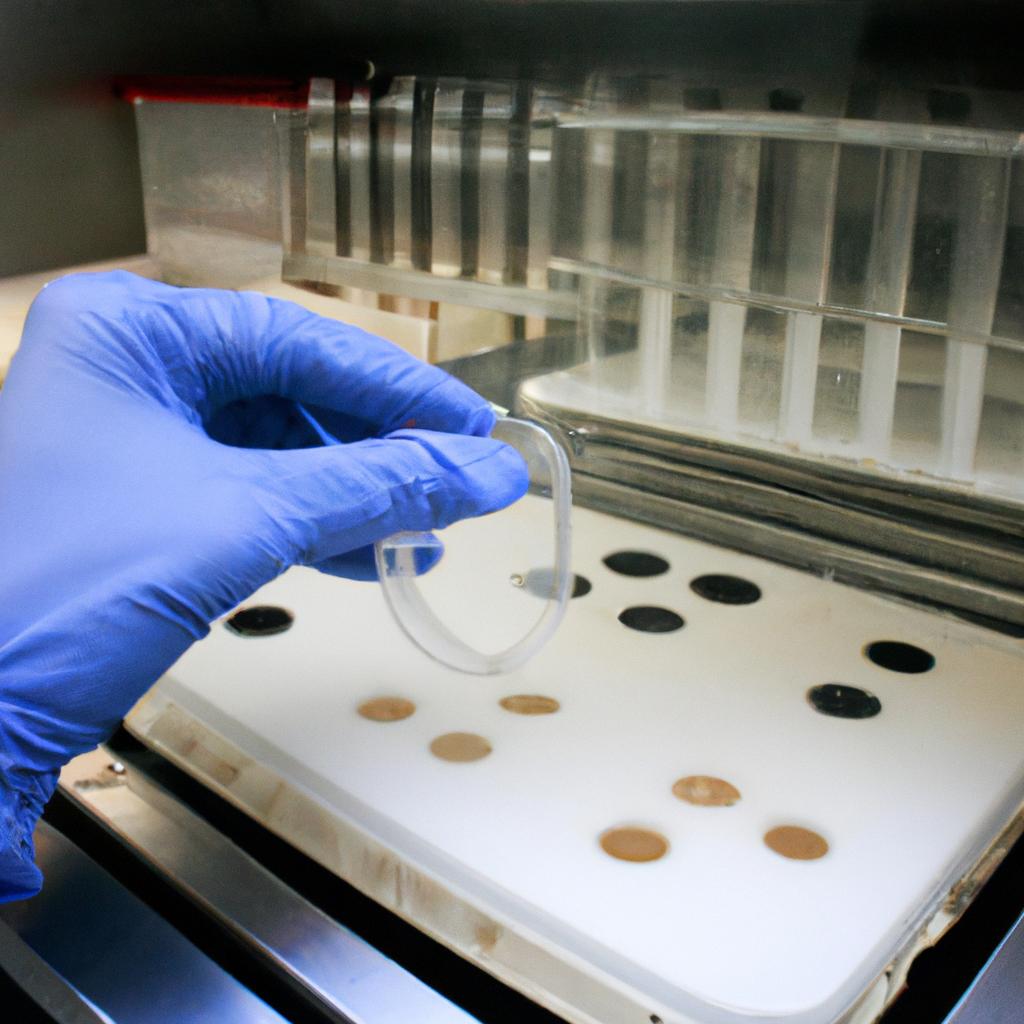Urinalysis holds a crucial role in the field of veterinary clinical pathology, providing valuable insights into clinical chemistry. By analyzing the composition and characteristics of urine samples obtained from animals, veterinarians can gain invaluable information about their patients’ overall health and identify potential underlying conditions. For instance, consider a hypothetical scenario where a feline patient presents with increased thirst and urination. Through urinalysis, clinicians can detect elevated glucose levels in the cat’s urine, leading them to suspect diabetes mellitus as a possible diagnosis. This example illustrates how urinalysis serves as an indispensable tool for assessing various physiological parameters that contribute to animal health.
In addition to aiding in disease diagnosis, urinalysis also offers essential guidance for monitoring treatment response and evaluating organ function in veterinary medicine. The analysis of urine specimens provides valuable data on renal function by assessing markers such as creatinine clearance or urinary protein concentration. Furthermore, it allows practitioners to monitor electrolyte imbalances, assess metabolic acid-base status, and evaluate drug excretion rates. These parameters are critical for optimizing therapeutic interventions and ensuring the well-being of animal patients throughout their treatment journeys.
As veterinary medicine continues to advance rapidly, incorporating technological advancements into routine practice has become increasingly important. Urinalysis remains one such area where emerging technology is revolutionizing the field. Automated urine analyzers, for example, can provide rapid and accurate results by utilizing advanced algorithms to analyze urine samples. These analyzers can measure a wide range of parameters, including specific gravity, pH, protein content, glucose levels, ketones, bilirubin, and various sediment components. This technology not only improves efficiency but also reduces human error in result interpretation.
Another emerging area in urinalysis is the use of molecular diagnostic techniques. Polymerase chain reaction (PCR) testing can detect the presence of infectious agents such as bacteria or viruses in urine samples. This allows for targeted treatment and helps prevent unnecessary antibiotic use.
Additionally, advancements in imaging techniques have enhanced our ability to visualize and assess urinary tract abnormalities. Ultrasound imaging provides detailed information about the kidneys, bladder, and ureters. It aids in identifying structural abnormalities such as stones or tumors that may be affecting urinary function.
Overall, incorporating these technological advancements into routine urinalysis practices allows veterinarians to obtain more accurate and comprehensive information about their patients’ health status. This ultimately leads to improved diagnosis and treatment outcomes in veterinary medicine.
Urinalysis methods in veterinary medicine
Urinalysis is a fundamental tool in veterinary clinical pathology that provides valuable insights into an animal’s health status. By examining the physical, chemical, and microscopic properties of urine, veterinarians can gain crucial information about various physiological processes occurring within the body. This section will explore different urinalysis methods commonly employed in veterinary medicine.
To illustrate the importance of urinalysis, let us consider a hypothetical case study involving a middle-aged dog presenting with increased thirst and frequent urination. The veterinarian suspects diabetes mellitus based on these clinical signs. Urinalysis plays a critical role in confirming this diagnosis by revealing the presence of glucose in the urine. Detecting abnormal levels of substances such as glucose, protein, ketones, or blood cells allows for early detection of diseases and prompt intervention.
When performing urinalysis, several methods are utilized to assess different aspects of urinary composition. These include visual examination, dipstick analysis, specific gravity determination, sediment evaluation, and microbial culture when necessary. Visual inspection involves observing characteristics such as color, clarity, odor, and volume of urine. Dipstick analysis aids in detecting abnormalities through assessing parameters like pH level, protein concentration, glucose content, and presence of leukocytes or nitrites.
The significance of interpreting urinalysis results cannot be overstated; therefore here is a bullet-point list highlighting its importance:
- Facilitates early detection and monitoring of renal disease.
- Provides insight into metabolic disorders such as diabetes mellitus or liver dysfunction.
- Aids in diagnosing urinary tract infections (UTIs) and identifying causative organisms.
- Helps evaluate therapeutic response to treatment interventions.
Furthermore, incorporating tables displaying reference ranges for various analytes found during urinalysis enhances comprehension and facilitates comparison between normal and abnormal values. For instance:
| Analyte | Normal Range | Abnormal Range |
|---|---|---|
| Glucose | Negative | Positive |
| Protein | Negative | Positive |
| pH Level | 5.5-7 | <5 or >8 |
| Leukocytes | Negative | Positive |
In summary, urinalysis methods in veterinary medicine encompass a range of techniques that are vital for assessing an animal’s health status. By utilizing these methods and interpreting the results accurately, veterinarians can diagnose diseases early on and provide prompt treatment interventions.
Interpreting urinary pH in clinical pathology
Insights into Clinical Chemistry: Interpreting Urinary pH in Veterinary Clinical Pathology
The analysis of urinary pH plays a crucial role in veterinary medicine as it provides valuable information about the acid-base balance and metabolic disorders present in animals. Understanding how to interpret urinary pH can aid in diagnosing various conditions and tailoring appropriate treatment plans. To illustrate its significance, let us consider an example involving a feline patient exhibiting signs of lower urinary tract disease.
In this case study, a domestic short-haired cat presents with frequent urination and straining during voiding. The veterinarian obtains a urine sample for analysis, including measuring the urinary pH. A high urinary pH is observed (pH > 7), indicating alkaline urine. This finding suggests that the patient may be suffering from idiopathic cystitis or urolithiasis caused by certain types of crystals commonly associated with alkaline urine.
When interpreting urinary pH values in clinical pathology, several factors should be considered:
- Diet: Certain diets can influence urinary pH levels due to their varying mineral compositions.
- Breed: Some breeds tend to have predispositions towards specific urinary abnormalities, which could affect the overall pH.
- Medications: Certain medications may alter the acidity or alkalinity of urine, affecting the measured pH value.
- Underlying diseases: Metabolic disorders such as renal dysfunction or respiratory disturbances can impact urinary pH.
To further comprehend how these factors play a role in interpreting urinary pH results, refer to Table 1 below:
| Factor | Effect on Urinary pH |
|---|---|
| High-protein diet | Acidic |
| Vegetarian diet | Alkaline |
| Siamese breed | More prone to acidic |
| Maine Coon breed | More prone to alkaline |
Understanding these considerations allows veterinarians to make informed decisions regarding diagnostic tests and tailored treatment strategies based on each individual’s unique circumstances. By taking into account the factors that influence urinary pH, veterinarians can effectively manage and treat conditions related to acid-base imbalances in their patients.
The significance of specific gravity in urinalysis will be explored in the subsequent section, shedding light on another critical aspect of clinical pathology associated with veterinary medicine. Transitioning seamlessly, let us now delve into this important topic.
The significance of specific gravity in urinalysis
Interpreting Urinary pH and the Significance of Specific Gravity in Urinalysis
Understanding Urine Composition through pH Analysis
Interpreting urinary pH is an essential aspect of clinical pathology as it provides valuable insights into a patient’s overall health. The measurement of urinary pH helps veterinarians assess acid-base balance, diagnose certain diseases, and monitor treatment effectiveness. For instance, let us consider a hypothetical case study involving a dog with recurrent urinary tract infections (UTIs). By analyzing the urine’s pH level over time, we can gather crucial information about the presence of infection or any underlying metabolic conditions.
To better understand the implications of urinary pH analysis, consider the following points:
- Acidic urine (pH < 7) suggests conditions such as metabolic acidosis, renal tubular acidosis, or high-protein diets.
- Alkaline urine (pH > 7) may indicate metabolic alkalosis, respiratory acidosis compensation, or urease-producing bacterial UTIs.
- Neutral urine (pH = 7) is typically observed in healthy animals but could also be seen during specific disease states.
The table below illustrates potential causes for different urinary pH levels:
| Urinary pH | Potential Causes |
|---|---|
| <6 | High protein diet; Metabolic acidosis |
| 6 – 8 | Normal range |
| >8 | Urease-producing bacteria |
Evaluating Renal Function Through Specific Gravity Measurement
Another critical parameter assessed during urinalysis is specific gravity. Specific gravity measures the concentration of solutes in urine and reflects the kidney’s ability to concentrate or dilute filtrate effectively. This assessment aids in evaluating renal function and identifying various pathological conditions.
Consider these key aspects related to specific gravity measurement:
- Low specific gravity (<1.008) may indicate renal dysfunction, diabetes insipidus, or excess fluid intake.
- High specific gravity (>1.030) suggests dehydration, kidney disease, or certain endocrine disorders.
- Normal specific gravity (between 1.008 and 1.030) is typically observed in healthy animals.
Through the analysis of urinary pH and specific gravity levels, veterinarians can gain significant insights into a patient’s health status and potential underlying conditions affecting the urinary system.
Transitioning from our discussion on interpreting urine composition parameters, we will now delve into detecting urinary tract infections in animals, highlighting essential diagnostic methods employed by veterinary professionals.
Detecting urinary tract infections in animals
Building upon the importance of understanding specific gravity in urinalysis, it is equally crucial to recognize the role of urine specific gravity (USG) in veterinary clinical pathology. By measuring USG, veterinarians can gain valuable insights into a variety of physiological and pathological conditions affecting animals’ urinary systems. This section will explore the significance of urine specific gravity analysis and its applications in diagnosing and monitoring various diseases.
Paragraph 1:
To comprehend the relevance of urine specific gravity, consider the case of an adult feline presenting with polyuria (excessive urination), polydipsia (increased thirst), and weight loss. Through comprehensive diagnostic investigations, including blood work and imaging techniques, no apparent abnormalities were detected. However, when assessing the patient’s urine specific gravity, a consistently low value was observed over several consecutive visits. This finding prompted further evaluation leading to a definitive diagnosis of chronic renal disease. The example highlights how analyzing urine specific gravity can provide critical information that complements other diagnostic tools for accurate identification and management of underlying conditions.
Paragraph 2:
Urine specific gravity serves as a quantitative measure reflecting the concentration or dilution status of animal urine. It evaluates the kidneys’ ability to regulate water reabsorption while eliminating waste products effectively. By employing refractometry or dipstick methods, veterinarians can obtain precise measurements that aid in diagnosing numerous disorders such as diabetes insipidus or syndrome of inappropriate antidiuretic hormone secretion (SIADH). Moreover, evaluating changes in urine-specific gravity allows for monitoring treatment efficacy during therapeutic interventions targeting these conditions.
- Identification of early-stage kidney dysfunction.
- Monitoring hydration levels in critically ill patients.
- Assessing response to diuretic therapy.
- Detecting dehydration caused by gastrointestinal disturbances.
Paragraph 3:
Table – Applications of Urine Specific Gravity Analysis:
| Application | Description |
|---|---|
| Detection of renal dysfunction | Identifies impaired kidney function |
| Evaluation of urinary concentrating ability | Assesses the kidneys’ ability to concentrate urine |
| Monitoring hydration status | Helps determine an animal’s fluid balance |
| Assessment of response to treatment | Allows tracking changes in specific gravity with therapeutic interventions |
In summary, urine specific gravity analysis plays a vital role in veterinary clinical pathology. Its applications extend beyond mere hydration assessment, encompassing the detection and monitoring of various diseases affecting animals’ urinary systems. By measuring urine-specific gravity accurately, veterinarians can provide effective diagnostic evaluations and facilitate appropriate treatment plans for their patients.
Understanding the role of urine sediment analysis further enhances our understanding of urinary system health and aids in comprehensive veterinary diagnostics.
Understanding the role of urine sediment analysis
Detecting urinary tract infections in animals is a crucial aspect of veterinary clinical pathology. By analyzing the urine, veterinarians can gain valuable insights into the health status of their patients. In this section, we will explore the role of urinalysis in identifying and diagnosing urinary tract infections (UTIs) in animals.
Consider the case of Max, a 5-year-old male Labrador Retriever presenting with increased frequency of urination and discomfort while urinating. Upon performing a urinalysis, the veterinarian observed significant levels of bacteria and leukocytes in Max’s urine, indicating a possible UTI. This example highlights how urinalysis serves as an effective tool for detecting such infections in animals.
To further understand the significance of urinalysis in detecting UTIs, let us delve into some key points:
- Urine culture: Performing a urine culture allows veterinarians to identify specific bacterial pathogens responsible for the infection.
- Sensitivity testing: Sensitivity testing helps determine which antibiotics are most effective against the identified pathogens.
- Interpretation of results: Analyzing various parameters such as white blood cells, red blood cells, pH level, protein concentration, and presence of crystals aids in interpreting the severity and nature of the infection.
- Monitoring treatment progress: Regular monitoring through sequential urinalyses enables evaluation of treatment efficacy and adjustment if necessary.
To illustrate these aspects further, consider Table 1 below showing hypothetical data from Max’s sequential urinalyses during his treatment for UTI:
Table 1 – Sequential Urinalysis Results
| Date | White Blood Cells (WBCs) | Red Blood Cells (RBCs) | Bacteria Present |
|---|---|---|---|
| Day 0 | High | None | Yes |
| Day 7 | Moderate | Few | No |
| Day 14 | Low | None | No |
| Day 21 | Normal | None | No |
As Max’s treatment progresses, the sequential urinalyses reveal a gradual decrease in white blood cell count and complete absence of bacteria, indicating successful resolution of the UTI.
In summary, urinalysis plays a pivotal role in detecting and monitoring urinary tract infections in animals. By analyzing various parameters and interpreting the results, veterinarians can accurately diagnose UTIs and assess treatment progress. The next section will delve into another important aspect of urinalysis – its diagnostic value in evaluating urinary protein analysis.
The diagnostic value of urinary protein analysis
Understanding the role of urine sediment analysis provides valuable insights into the health status of animals in veterinary clinical pathology. By examining the cellular components and structures present in urine, veterinarians can gather essential information about various diseases and conditions that may affect their patients. This section explores the diagnostic value of urinary protein analysis as an additional tool to aid in diagnosing and monitoring these conditions.
To illustrate the significance of urinary protein analysis, let us consider a hypothetical case study involving a middle-aged dog presenting with recurrent episodes of excessive urination and increased thirst. Upon microscopic examination of the urine sediment, numerous red blood cells (RBCs) are observed, suggesting potential kidney damage or inflammation. In addition to evaluating RBC counts, urinary protein analysis can provide further insight into this condition by assessing the presence and quantity of proteins in the urine.
Urinary protein analysis offers several advantages for diagnostic purposes:
- Early detection: Proteinuria, or elevated levels of protein in urine, can be an early indicator of renal dysfunction or disease before other clinical signs manifest.
- Disease monitoring: By regularly analyzing urinary protein levels, veterinarians can track disease progression and monitor treatment efficacy over time.
- Differential diagnosis: Identifying specific types of proteins present in urine through advanced techniques such as electrophoresis allows differentiating between various etiologies, aiding in accurate diagnosis.
- Prognostic value: The severity and persistence of proteinuria may serve as prognostic indicators for certain conditions, helping guide treatment decisions and providing crucial information regarding long-term outcomes.
Table 1 below highlights some common causes associated with abnormal findings on urinary protein analysis:
| Abnormal Finding | Possible Causes |
|---|---|
| Persistent Proteinuria | Chronic kidney disease |
| Hematuria | Urinary tract infection |
| Glucosuria | Diabetes mellitus |
| Pyuria | Bacterial or fungal urinary tract infection |
In summary, understanding the role of urine sediment analysis and incorporating urinary protein analysis in veterinary clinical pathology can significantly contribute to disease diagnosis, monitoring, and prognosis. By assessing various cellular components and evaluating protein levels in urine, veterinarians gain valuable information about underlying conditions affecting their patients. This comprehensive approach enhances diagnostic accuracy and enables more effective treatment strategies for improved patient care.
Table 1:
| Abnormal Finding | Possible Causes |
|-----------------------|---------------------------------------------|
| Persistent Proteinuria| Chronic kidney disease |
| Hematuria | Urinary tract infection |
| Glucosuria | Diabetes mellitus |
| Pyuria | Bacterial or fungal urinary tract infection |
 Vet Clin Path Journal
Vet Clin Path Journal



